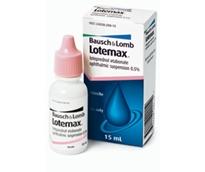Lotemax Disease Interactions
There are 2 disease interactions with Lotemax (loteprednol ophthalmic).
Ophthalmic corticosteroids (applies to Lotemax) ocular infections
Major Potential Hazard, High plausibility.
The use of ophthalmic corticosteroids is contraindicated in most viral diseases of the cornea and conjunctiva, including epithelial herpes simplex keratitis (dendritic keratitis), vaccinia, and varicella; fungal diseases of ocular structures; mycobacterial infections, including tuberculosis, of the eye; and any acute, purulent, untreated ocular infections. Corticosteroids may decrease host resistance to infectious agents, thus prolonging the course and/or exacerbating the severity of the infection while encouraging the development of new or secondary infection. In addition, administration of ophthalmic corticosteroids in severe ocular disease, especially acute herpes simplex keratitis, may lead to excessive corneal and scleral thinning, increasing the risk for perforation. In less serious ocular infections, therapy with ophthalmic corticosteroids may be administered but only with caution and accompanied by appropriate antimicrobial agents. Besides compromising host immune response, corticosteroids may also mask the symptoms of infection, thus hindering the recognition of potential ineffectiveness of the antibiotic therapy. If infection does not improve or becomes worse during administration of an ophthalmic corticosteroid, the drug should be discontinued and other appropriate therapy initiated.
Ophthalmic corticosteroids (applies to Lotemax) ocular toxicities
Major Potential Hazard, High plausibility. Applicable conditions: Cataracts, Glaucoma/Intraocular Hypertension
Prolonged use of corticosteroids may cause posterior subcapsular cataracts and elevated intraocular pressure, the latter of which may lead to glaucoma and/or damage to the optic nerves. Therapy with ophthalmic corticosteroids should be administered cautiously in patients with a history of cataracts, glaucoma, or increased intraocular pressure. If these agents are used for more than 10 days, the manufacturers recommend that intraocular pressure be routinely monitored, including in children. The equatorial and posterior subcapsular portions of the lens should be examined for changes.
Switch to professional interaction data
Lotemax drug interactions
There are 43 drug interactions with Lotemax (loteprednol ophthalmic).
More about Lotemax (loteprednol ophthalmic)
- Lotemax consumer information
- Check interactions
- Compare alternatives
- Pricing & coupons
- Reviews (18)
- Drug images
- Side effects
- Dosage information
- During pregnancy
- Generic availability
- Drug class: ophthalmic steroids
- Breastfeeding
- En español
Related treatment guides
Drug Interaction Classification
| Highly clinically significant. Avoid combinations; the risk of the interaction outweighs the benefit. | |
| Moderately clinically significant. Usually avoid combinations; use it only under special circumstances. | |
| Minimally clinically significant. Minimize risk; assess risk and consider an alternative drug, take steps to circumvent the interaction risk and/or institute a monitoring plan. | |
| No interaction information available. |
See also:
Further information
Always consult your healthcare provider to ensure the information displayed on this page applies to your personal circumstances.


